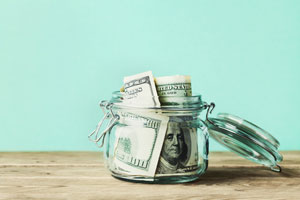Safe Money: Weighing Savings Options in a Low-Interest Rate Environment

Keeping money in an account whose interest rate hovers below 1% may not hold much appeal in a world where return on investment is king and memories of much higher rates linger. But even amid the current prolonged period of exceedingly low interest rates, there are compelling reasons for consumers to keep cash in a vehicle such as a savings account, money market account or certificate of deposit (CD).
“Having three to six months of cash accessible in some type of savings account for emergencies is essential,” says Ashley O’Kurley, a certified financial planner based in Miami, Fla., “for the liquidity, flexibility and mobility that come with it.”
Think of the money residing in such an account as an investment designed not to generate financial return, or yield, so much as one that provides a vital safety net to cover up to six months of living expenses in case of a lost job or other type of unforeseen financial crisis, O’Kurley suggests. “We have to temper our desire to get a big yield on every dollar we have. The first lesson of Financial Planning 101 is to have cash on hand for emergencies.”
While yield is a secondary consideration in choosing between a CD, a money market account, an online or brick-and-mortar savings account, or some other vehicle to house “safe money,” the decision about where to stash that cash does have important financial ramifications, he explains. “You can earn hundreds of dollars for yourself over time simply by moving money from an FDIC-insured checking account where it’s earning nothing to a high-yield savings account where it can earn 80, 90 even 100 basis points (100 basis points equates to a 1% interest rate), that’s also FDIC-insured.”
Did You Know?
 You have access to hundreds of interactive financial calculators that will help you solve problems from rent versus buy to save versus invest.
You have access to hundreds of interactive financial calculators that will help you solve problems from rent versus buy to save versus invest.
Since the priority for an emergency cash reserve is not only ready access to funds but the safety of those funds, he suggests putting it in a vehicle that’s FDIC-insured, meaning it’s backed by the Federal Deposit Insurance Corporation, a government entity, for a specified amount — typically $250,000. So if the institution holding the account fails for any reason, FDIC backing assures the account holder still will be able to recoup their money.
Which type of FDIC-backed savings vehicle is best in the prevailing low-interest-rate environment? Here’s a look at the options:
Online high-yield savings account. Today the savings accounts with the highest rates — sometimes 1% or perhaps a tick above — are often found online. “Online savings accounts end up being the best solution in many cases,” says O’Kurley. However, be aware that these accounts come with moving parts. Some carry attractive initial rates that quickly revert to less attractive lower rates. Others couple a relatively high interest rate with a higher minimum balance. Given these distinctions, it pays to spend some time comparison-shopping, with www.bankrate.com a good place to start.
Savings account from a brick-and-mortar bank. People who prefer to do their banking offline, person-to-person, may prefer to open a savings account at a local bank. They’ll likely earn a lower interest rate as a result.
Certificate of deposit. Gone are the days when interest rates for short-term three-month or six-month CDs consistently and substantially exceeded those of traditional savings accounts. These days, securing a higher interest rate with a CD often means committing to keep money in the account longer term — for one, three or even five years. Thus CDs limit flexibility, as the extra return they provide can be quickly erased by penalties for early withdrawal. The trade-off — sacrificing accessibility to that cash simply to earn a little extra money in interest — often isn’t worth it, O’Kurley says. “CDs are what they have always been: FDIC-insured accounts you get from a brick-and-mortar bank. But you’ll give up liquidity to get one.” Parking money in a CD for several years also comes with interest rate risk. Should interest rates rise, a lower rate would still apply to the money inside the CD, precluding the CD owner from earning a higher rate on that money. People who are willing to live with that risk while sacrificing a measure of liquidity with a CD can comparison-shop at www.bankrate.com.
Checking account. While most checking accounts are FDIC-insured and some pay interest, not only do their interest rates rarely match those of savings accounts (particularly online savings accounts), they also may come with a range of restrictions and requirements, including minimum initial deposits, transactions fees and other costs that can add up quickly. For those reasons, checking accounts typically are better suited to house money you intend to spend, not save.
Money market account. As with CDs, money market accounts no longer hold much of an interest rate edge over savings accounts, which is why O’Kurley says he rarely recommends them to clients. While they could regain that edge when interest rates bounce higher, there’s no telling when that may happen. Still, because most money market accounts are FDIC-insured, as modest as their interest rates are, they remain a viable, if lower-yielding, option for stowing “safe money.”
The Financial Planning Association (FPA) © 2020
